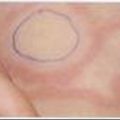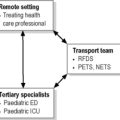6.7 Croup
Introduction
The lower airway involvement of laryngotracheobronchitis may also cause younger children to manifest wheeze due to concurrent inflammation producing mucus in the smaller peripheral airways. Likewise, occasionally older children known to have asthma may exhibit signs of asthma in the setting of croup.1
Presentation
Examination
Croup in children can generally be classified as mild, moderate, or severe (Table 6.7.1).
After Marks et al 2003.2
Investigations
Croup is usually an easy ‘spot diagnosis’ and requires no diagnostic tests.
Oximetry is of limited value, as children may maintain near-normal oxygen saturations even when they have significant airway obstruction.3 While it may have a role in cases of severe croup, this must be balanced with the distress caused by the monitoring probe in small children. In stable cases, where the diagnosis is unclear, a lateral soft tissue X-ray of the neck may be helpful to distinguish croup from epiglottitis or retropharyngeal abscess. However, the possible benefits of an X-ray need to be weighed against the risks of moving or disturbing the child when the obstruction is more than mild. A nasopharyngeal aspirate in croup is not necessary for diagnosis but may be useful for infection control for patients being admitted.
Differential diagnosis
It is important to establish that other, more sinister, causes of acute upper respiratory tract obstruction masquerading as croup are not present (Table 6.7.2). Especially in the younger child, one should enquire regarding longer-term symptoms preceding the present episode, such as low-grade stridor. This might suggest underlying congenital airway or vascular anomaly (e.g. tracheomalacia, subglottic stenosis, bilateral cord paralysis, laryngeal web, or vascular ring compression of the trachea). One should also enquire as to possible airway trauma or toxic ingestion. Dysphagia and drooling may suggest epiglottitis, peritonsillar or retropharyngeal abscess, or foreign body in the airway or oesophagus.
Treatment and disposition
Mild or moderate croup
All children who present to an emergency department with croup should be treated with steroids.4 The mandatory use of steroids for croup in emergency departments results in a reduction in the relapse rate of those sent home,5 the average length of stay in hospital falling, and the number of children needing intensive care and intubation dramatically reducing.6,7 Prior to the regular use of steroids, a general rule of thumb was to admit children with stridor at rest (moderate) to hospital for observation, while allowing those with occasional stridor and barking cough only (mild) to be managed at home. As many children will improve within a few hours of taking steroids, often they may be discharged home after a short stay in the emergency department or an observation ward. Factors such as the distance from medical care, the availability of transport, the time of day, the child’s past history with regard to severe airway obstruction, and parental concern and attitude all need to be taken into account when making the decision to admit (Table 6.7.3).
Recommended steroid doses are oral dexamethasone in a one-off dose of 0.15 mg kg–1,8 or an equivalent dose of prednisolone of 0.75 mg kg–1. Most children with croup will require only one dose, but if the upper airway obstruction symptoms persist (as opposed to upper respiratory tract infection symptoms), a further dose may be given 18 to 24 hours later. It is often more convenient to use prednisolone (rounded off to 1 mg kg–1) in the community, as it is more readily available. While one study9 suggested that children treated with prednisolone may re-present more commonly than those treated with dexamethasone, Fifoot et al10 did not confirm this finding. Steroids may be administered intramuscularly or intravenously in the child with severe obstruction, when there is concern that the child may aspirate or vomit, given their degree of respiratory difficulty.
Oral dexamethasone has been found to be as effective as inhaled steroids such as budesonide,11 and to work as fast, at a fraction of the cost. A blinded randomised trial, submitted for publication, of dexamethasone 0.15 mg kg–1 compared to placebo that looked at croup scores at 10-minute intervals after administration showed a significant difference at 30 minutes.12 Combining dexamethasone and budesonide is no more effective than dexamethasone alone.11,13 There is no place for antibiotics in a typical case of croup. The use of ‘steam’ or humidified air is unproven,14,15 despite its once common usage. The anecdotal report by parents of their child improving in the steam-filled bathroom at home is due to the defervescing of crying which occurs from cuddling in the room by the parent, rather than any steam effect.
Severe croup
Children with manifestations of severe obstruction should be given nebulised adrenaline (epinephrine). It is generally considered that adrenaline does not change the natural history of croup, such as length of stay in hospital or need to intubate, due to its short-lasting effects. It will, however, ‘buy time’ while waiting for the effect of steroids to occur. Rarely, in a worst-case scenario, adrenaline can be a useful temporising measure while organising the facilities and appropriate personnel for a child who may require intubation. The recommended dose (independent of age and weight) is 5 mL of 1:1000, nebulised with oxygen, which can be used for all children. This may be repeated after 10 minutes if needed and may help avoid the need for intubation in children who respond to steroids. ‘Rebound’ phenomenon may occur, where the upper airway obstruction may recur as the effect of the adrenaline wears off after 1–2 hours. While in the past it was recommended that any child who received adrenaline for croup should be admitted, a number of studies have now shown that children may be sent home safely if they have also received steroids and have improved to have no stridor at rest over a number of hours.16,17 Children receiving nebulised adrenaline require close clinical monitoring of their response, particularly the change in air entry, in order to detect any deterioration.
Intubation needs to be considered in the child who has increasing upper airway obstruction, hypoxia, decreasing conscious state, or fatigue despite nebulised adrenaline. These children should be discussed early with a paediatric intensivist in order to optimise management. The ideal setting for this to occur is in theatre or a paediatric intensive care unit environment via gaseous induction, using an endotracheal tube 1.0-mm smaller than predicted by the child’s size (see Chapter 2.3).
Prevention
Controversies and future research
 Although once controversial, steroids are now generally accepted for all children who present to emergency departments with croup.
Although once controversial, steroids are now generally accepted for all children who present to emergency departments with croup. It is clear that both prednisolone and dexamethasone are effective in the treatment of croup; however, two direct comparisons have not resolved the question on whether the shorter half life of prednisolone results in more ‘relapses’ at home. While a once-only dose of dexamethasone is sufficient for the vast majority of children with croup, a second dose of prednisolone 24 hours later may be needed in some cases.
It is clear that both prednisolone and dexamethasone are effective in the treatment of croup; however, two direct comparisons have not resolved the question on whether the shorter half life of prednisolone results in more ‘relapses’ at home. While a once-only dose of dexamethasone is sufficient for the vast majority of children with croup, a second dose of prednisolone 24 hours later may be needed in some cases.1 Denny F.W., Clyde W.A. Acute lower respiratory tract infections in nonhospitalized children. J Pediatr. 1986;108:635-645.
2 Marks M., Wilkinson D., Munro J. Paediatric Handbook, 6th ed. Victoria: Blackwell Science; 2003.
3 Stoney P.J., Chakrabarti M.K. Experience of pulse oximetry in children presenting with croup. J Laryngol Otol. 1991;105:295-298.
4 Geelhoed G.C. Croup. Pediatr Pulmonol. 1997;23(5):370-374.
5 Geelhoed G.C., Turner J., Macdonald W.B. Efficacy of a small single dose of oral dexamethasone for outpatient croup: A double blind placebo controlled clinical trial. Br Med J. 1996;313(7050):140-142.
6 Geelhoed G.C. Sixteen years of croup in a Western Australian teaching hospital: The impact of routine steroid treatment. Ann Emerg Med. 1996;28(6):621-626.
7 Dobrovoljac M., Geelhoed G.C. 27 years of croup: an update highlighting the effectiveness of 0.15 mg/kg of dexamethasone. Emerg Med Australas. 2009;21:309-314.
8 Geelhoed G.C., Macdonald W.G.B. Oral dexamethasone in the treatment of croup: 0.15 mg/kg is as effective as 0.3 mg/kg or 0.6 mg/kg. Pediatr Pulmonol. 1995;20:362-367.
9 Sparrow A., Geelhoed G.C. Prednisolone versus dexamethasone in croup: A randomised equivalence trial. Arch Dis Child. 2006;91:580-583.
10 Fifoot A.A., Ting J.Y.S. Comparison between single-dose oral prednisolone and oral dexamethasone in the treatment of croup: a randomized, double-blinded clinical trial. Emerg Med Australasia. 2007;19:51-58.
11 Klassen T.P., Craig W.R., Moher D., et al. Nebulized budesonide and oral dexamethasone for treatment of croup: A randomized controlled trial. JAMA. 1998;279(20):1629-1632.
12 Dobrovoljac M., Geelhoed G.C. How fast does oral dexamethasone work in croup patients? A randomised double blinded clinical trial. Emerg Med Australasia. 2009;21(4):309-314.
13 Geelhoed G.C. Budesonide offers no advantage when added to oral dexamethasone in the treatment of croup. Pediatr Emerg Care. 2005;21:359-362.
14 Neto G.M., Kentab O., Klassen T.P., et al. A randomized controlled trial of mist in the acute treatment of moderate croup. Acad Emerg Med. 2002;9:873-879.
15 Bouchier D., Dawson K.P., Fergusson D.M. Humidification in viral croup: A controlled trial. Aust Paediatr J. 1984;20:289-291.
16 Kelley P.B., Simon J.E. Racemic epinephrine use in croup and disposition. Am J Emerg Med. 1992;10(3):181-183.
17 Prendergast M., Jones J.S., Hartman D. Racemic epinephrine in the treatment of laryngotracheitis: Can we identify children for outpatient therapy? Am J Emerg Med. 1994;12(6):613-616.





